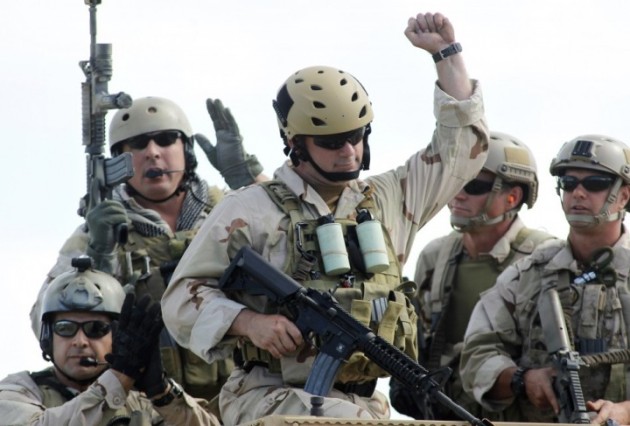Leading from behind? Isn’t that an oxymoron, like organized chaos, or a genuine fake? “Leading from behind” normally connotes a leader reacting to and being led by events rather than getting out in front of problems, setting objectives, and inspiring his/her organization to achieve great things.
I will make the case however, that the best leaders of the best organizations know that they are often more effective leading from behind, and “letting the dogs run.” They can, and do, lead from the front, when that is what the circumstances and the team demand, but they often prefer to plant themselves back in the crowd – watching others lead, and employing more subtle approaches to influencing events, rather than trying to always be in total control.
If a team is new and still defining itself, or if it is facing an urgent task, or if it is confused or struggling with internal conflict, there is clearly a need for strong lead-from-the-front leadership to develop positive forward momentum. But once the team is on track and performing well, leading from behind can increase momentum and develop long term and sustainable success.
When a team is “humming,” and everyone knows their job, when everyone is committed to a common vision and holds each other accountable to the mission, THAT’s when the best leaders exercise lead-from-behind leadership; they step out of the way and let things run. That doesn’t mean they disengage. They remain extremely engaged – by watching carefully, staying in touch with what is happening, providing support and insight as necessary, and making command decisions when command decisions are called for. They understand that it is easier to assess whether the team is moving out on the right azimuth when they can view the entire field.
When the team is working well, a lead-from-behind leader is able to look out beyond the next couple of ridgelines, consider how best to prepare the team for what might be coming, and how best to take it to the next level, when it is ready. And when it is ready, the leader knows it will probably be time to get out front again, to help the team create a new direction, a new vision, new commitment, and establish a new momentum, before once again, stepping to the side.
Letting a well-oiled team run, frees up the leader to serve the team beyond the boundaries of the team, to build credibility with other teams and higher headquarters, and to spend more time and energy looking at the broader context of the team’s mission. Management is left to the well-functioning internal mechanisms of the team.
Great leaders train and prepare future leaders. Lead-from-behind leadership allows the leader to look up and out, while giving junior leaders opportunities to lead, learn and grow. One of the best ways to build other leaders is to let them lead, and when designated leaders step out of the way, others can spread their wings, use their judgment, make decisions, and make mistakes. The lead-from-behind leader remains engaged by being available to coach, to make sure mistakes don’t take things too far off track, and to provide constructive feedback after the fact. Only by letting others lead can the leader effectively judge who has the most potential, and who is most ready to assume increased responsibility within the organization.
When I was younger, I made the mistake that many young leaders make: I believed my role was to always be out front. And like many young leaders, I enjoyed the spotlight, the authority, and the ego satisfaction of being in charge and “making stuff happen.” For most of us, this is probably a necessary phase in our development as leaders, but I’ve seen far too many leaders never get beyond this phase. When the leader is always out in front, others who might be very capable and ready, are not leading, and opportunities for them to grow and develop are missed. The team becomes completely dependent on the leader’s energy, drive, and ambition. That is not good for the long term development of the team and its people.
Later in my career, I struggled to back off my tendency to always jump out front, and I tried to step back more, and let the organization evolve. I realized that if my team expected me to always take charge as problems arose, they would simply sit back and wait to see what I decided. That was not what I wanted. I had to learn that it was not about me – it was about them. I was THEIR leader; they were not MY troops. There is a big difference.
Through trial and error, reading, and watching other leaders succeed and fail, I discovered that in great organizations, great leaders are often leading from behind. To outsiders, it is not always clear how great leader’s influence with subtlety, insight, and example. In his seminal work Good to Great, Jim Collins describes these leaders as “Level 5 Leaders.” Harvard’s Joe Badaraccco praises such selfless leaders as “non-heroic” leaders. One key NSW leader speaks of leading with “humility, integrity, and transparency.”
Great leaders like to step out of the spotlight and put the spotlight on others in their organization. In doing so, they become more a part of the organization’s collective “We.” They use the collective “We” and “Our” in most discourse, and avoid excessive use of “I” and “my.” When the leader is constantly saying “We,” and acting in a “We” way, those on the team begin to believe in ‘We” and commit to the larger “We,” rather than simply, to the leader.
“With the best of leaders, when the work is done, the project completed, the people all say, ‘We did it ourselves.’” (Tao Te Ching)
Great leaders know how to balance leading from the front and leading from behind. While they certainly know when and how to get out front and push, they also know when it is best to step to the side, let things evolve on their own, let other leaders emerge, influence subtly, and lead quietly, from behind.
About the Author:
Bob Schoultz has an undergraduate degree in Philosophy from Stanford University and an MA in National Security Affairs from the Naval War College where he also served on the faculty as the first chair for Special Operations. Schoultz retired from the Navy in July 2005 as a captain after a 30 year career, nearly all in Naval Special Warfare. He commanded Navy Seals at all levels up to captain, lived overseas for four tours and participated in military contingency operations all over the world. His final tour in the Navy was at the Naval Academy where he completed a nine month fellowship with the Center for the Study of Professional Military Ethics and in his final two years was the director of Character Development and ultimately the director of Character and Leadership Development. He is also a certified instructor with the National Outdoor Leadership School.



Leave a Reply
You must be logged in to post a comment.